Response Surface Methodology (RSM) on the Hybrid Nanofluid Flow Subject to a Vertical and Permeable Wedge
Abstract
1. Introduction
2. Mathematical Formulation
- The variable wall temperature is where is a characteristic length of the wedge, corresponds to an assisting flow (heated wedge), while denotes an opposing flow (cooled wedge);
- The far-field temperature is fixed (constant);
- Both nanoparticles and base fluid are in a thermal equilibrium state;
- The model excludes the effect of sedimentation/aggregation since the hybrid nanofluid is in a stable synthesis.
3. Results and Discussion
4. Response Surface Methodology
5. Conclusions
- The steady flow problem was solved for three cases: assisting flow, opposing flow, and pure force convective flow. The dual solutions were observable only in the opposing flow region when appropriate parameters were used;
- From the numerical evaluation, the addition of the wedge parameter, the volumetric concentration of nanoparticles, and the suction parameter contribute to the expansion of the critical value, which implies the delay in boundary layer separation. Furthermore, the skin friction coefficient and heat transfer process in the opposing flow region were also raised by these controlling parameters;
- From the statistical evaluation, the two responses (heat transfer rate and skin friction coefficient) were significantly affected by the wedge and volumetric concentration of nanoparticles factors. However, the effect of the suction parameter is only relevant for the heat transfer rate and not for the skin friction coefficient;
- Nonetheless, all models account for a significant part of the total variation in the responses. Moreover, the residuals of both fitted models were also demonstrated to be normally distributed and well-fitted.
Author Contributions
Funding
Data Availability Statement
Acknowledgments
Conflicts of Interest
References
- Shah, N.A.; Wakif, A.; El-Zahar, E.R.; Ahmad, S.; Yook, S.J. Numerical simulation of a thermally enhanced EMHD flow of a heterogeneous micropolar mixture comprising (60%)-ethylene glycol (EG),(40%)-water (W), and copper oxide nanomaterials (CuO). Case Stud. Therm. Eng. 2022, 35, 102046. [Google Scholar] [CrossRef]
- Sabu, A.S.; Wakif, A.; Areekara, S.; Mathew, A.; Shah, N.A. Significance of nanoparticles’ shape and thermo-hydrodynamic slip constraints on MHD alumina-water nanoliquid flows over a rotating heated disk: The passive control approach. Int. Commun. Heat Mass Transf. 2021, 129, 105711. [Google Scholar] [CrossRef]
- Rasool, G.; Shah, N.A.; El-Zahar, E.R.; Wakif, A. Numerical investigation of EMHD nanofluid flows over a convectively heated riga pattern positioned horizontally in a Darcy-Forchheimer porous medium: Application of passive control strategy and generalized transfer laws. Waves Random Complex Media 2022, 1–20. [Google Scholar] [CrossRef]
- Jana, S.; Salehi-Khojin, A.; Zhong, W.H. Enhancement of fluid thermal conductivity by the addition of single and hybrid nano-additives. Thermochim. Acta 2007, 462, 45–55. [Google Scholar] [CrossRef]
- Suresh, S.; Venkitaraj, K.P.; Selvakumar, P.; Chandrasekar, M. Synthesis of Al2O3-Cu/water hybrid nanofluids using two step method and its thermo physical properties. Colloids Surf. A Physicochem. Eng. Asp. 2011, 388, 41–48. [Google Scholar] [CrossRef]
- Takabi, B.; Salehi, S. Augmentation of the heat transfer performance of a sinusoidal corrugated enclosure by employing hybrid nanofluid. Adv. Mech. Eng. 2014, 6, 147059. [Google Scholar] [CrossRef]
- Devi, S.P.A.; Devi, S.S.U. Numerical investigation of hydromagnetic hybrid Cu-Al2O3/water nanofluid flow over a permeable stretching sheet with suction. Int. J. Nonlinear Sci. Numer. Simul. 2016, 17, 249–257. [Google Scholar] [CrossRef]
- Nabwey, H.A.; Mahdy, A. Transient flow of micropolar dusty hybrid nanofluid loaded with Fe3O4-Ag nanoparticles through a porous stretching sheet. Results Phys. 2021, 21, 103777. [Google Scholar] [CrossRef]
- Roy, N.C.; Hossain, M.A.; Pop, I. Analysis of dual solutions of unsteady micropolar hybrid nanofluid flow over a stretching/shrinking sheet. J. Appl. Comput. Mech. 2021, 7, 19–33. [Google Scholar] [CrossRef]
- Riaz, A.; Ellahi, R.; Sait, S.M. Role of hybrid nanoparticles in thermal performance of peristaltic flow of Eyring–Powell fluid model. J. Therm. Anal. Calorim. 2021, 143, 1021–1035. [Google Scholar] [CrossRef]
- Khashi’ie, N.S.; Waini, I.; Zokri, S.M.; Kasim, A.R.M.; Arifin, N.M.; Pop, I. Stagnation point flow of a second-grade hybrid nanofluid induced by a Riga plate. Int. J. Numer. Methods Heat Fluid Flow 2021, 32, 2221–2239. [Google Scholar] [CrossRef]
- Abbas, N.; Nadeem, S.; Malik, M.Y. Theoretical study of micropolar hybrid nanofluid over Riga channel with slip conditions. Phys. A Stat. Mech. Its Appl. 2020, 551, 124083. [Google Scholar] [CrossRef]
- Waqas, H.; Farooq, U.; Naseem, R.; Hussain, S.; Alghamdi, M. Impact of MHD radiative flow of hybrid nanofluid over a rotating disk. Case Stud. Therm. Eng. 2021, 26, 101015. [Google Scholar] [CrossRef]
- Bilal, M.; Khan, I.; Gul, T.; Tassaddiq, A.; Alghamdi, W.; Mukhtar, S.; Kumam, P. Darcy-forchheimer hybrid nano fluid flow with mixed convection past an inclined cylinder. Comput. Mater. Contin. 2021, 66, 2025–2039. [Google Scholar] [CrossRef]
- Uysal, C.; Korkmaz, M.E. Estimation of Entropy Generation for Ag-MgO/Water Hybrid Nanofluid Flow through Rectangular Minichannel by Using Artificial Neural Network. J. Polytech. 2019, 22, 41–51. [Google Scholar] [CrossRef]
- Kumar, V.; Sarkar, J. Particle ratio optimization of Al2O3-MWCNT hybrid nanofluid in minichannel heat sink for best hydrothermal performance. Appl. Therm. Eng. 2020, 165, 114546. [Google Scholar] [CrossRef]
- Salehi, S.; Nori, A.; Hosseinzadeh, K.; Ganji, D.D. Hydrothermal analysis of MHD squeezing mixture fluid suspended by hybrid nanoparticles between two parallel plates. Case Stud. Therm. Eng. 2020, 21, 100650. [Google Scholar] [CrossRef]
- Zainal, N.A.; Nazar, R.; Naganthran, K.; Pop, I. Viscous dissipation and MHD hybrid nanofluid flow towards an exponentially stretching/shrinking surface. Neural Comput. Appl. 2021, 33, 11285–11295. [Google Scholar] [CrossRef]
- Zainal, N.A.; Nazar, R.; Naganthran, K.; Pop, I. Unsteady MHD mixed convection flow in hybrid nanofluid at three-dimensional stagnation point. Mathematics 2021, 9, 549. [Google Scholar] [CrossRef]
- Zainal, N.A.; Nazar, R.; Naganthran, K.; Pop, I. Heat generation/absorption effect on MHD flow of hybrid nanofluid over bidirectional exponential stretching/shrinking sheet. Chin. J. Phys. 2021, 69, 118–133. [Google Scholar] [CrossRef]
- Khashi’ie, N.S.; Arifin, N.M.; Sheremet, M.; Pop, I. Shape factor effect of radiative Cu–Al2O3/H2O hybrid nanofluid flow towards an EMHD plate. Case Stud. Therm. Eng. 2021, 26, 101199. [Google Scholar] [CrossRef]
- Khashi’ie, N.S.; Waini, I.; Zainal, N.A.; Hamzah, K.B. Hybrid nanofluid flow past a shrinking cylinder with prescribed surface heat flux. Symmetry 2020, 12, 1493. [Google Scholar] [CrossRef]
- Khashi’ie, N.S.; Arifin, N.M.; Wahi, N.; Pop, I.; Nazar, R.; Hafidzuddin, E.H. Thermal marangoni flow past a permeable stretching/shrinking sheet in a hybrid Cu-Al2O3/water nanofluid. Sains Malays. 2020, 49, 211–222. [Google Scholar] [CrossRef]
- Khashi’ie, N.S.; Arifin, N.M.; Pop, I. Magnetohydrodynamics (MHD) boundary layer flow of hybrid nanofluid over a moving plate with Joule heating. Alex. Eng. J. 2021, 61, 1938–1945. [Google Scholar] [CrossRef]
- Waini, I.; Ishak, A.; Pop, I. Hybrid nanofluid flow on a shrinking cylinder with prescribed surface heat flux. Int. J. Numer. Methods Heat Fluid Flow 2021, 31, 1987–2004. [Google Scholar] [CrossRef]
- Waini, I.; Ishak, A.; Pop, I. Flow towards a stagnation region of a vertical plate in a hybrid nanofluid: Assisting and opposing flows. Mathematics 2021, 9, 448. [Google Scholar] [CrossRef]
- Waini, I.; Ishak, A.; Pop, I. MHD stagnation point flow and heat transfer towards a permeable stretching/shrinking surface in a hybrid nanofluid. Sains Malays. 2021, 50, 2819–2832. [Google Scholar] [CrossRef]
- Waini, I.; Ishak, A.; Pop, I. Hybrid nanofluid flow with homogeneous-heterogeneous reactions. Comput. Mater. Contin. 2021, 68, 3255–3269. [Google Scholar] [CrossRef]
- Waini, I.; Ishak, A.; Pop, I. Flow towards a stagnation region of a curved surface in a hybrid nanofluid with buoyancy effects. Mathematics 2021, 9, 2330. [Google Scholar] [CrossRef]
- Shah, N.A.; Wakif, A.; El-Zahar, E.R.; Thumma, T.; Yook, S.J. Heat transfers thermodynamic activity of a second-grade ternary nanofluid flow over a vertical plate with Atangana-Baleanu time-fractional integral. Alex. Eng. J. 2022, 61, 10045–10053. [Google Scholar] [CrossRef]
- Falkner, V.M.; Skan, S.W. Some approximate solutions of the boundary layer equations. Philos. Mag. 1931, 12, 865–896. [Google Scholar] [CrossRef]
- Hartree, D.R. On an equation occurring in Falkner and Skan’s approximate treatment of the equations of the boundary layer. Math. Proc. Camb. Philos. Soc. 1937, 33, 223–239. [Google Scholar] [CrossRef]
- Ahmad, R.; Khan, W.A. Numerical study of heat and mass transfer MHD viscous flow over a moving wedge in the presence of viscous dissipation and heat source/sink with convective boundary condition. Heat Transf.-Asian Res. 2014, 43, 17–38. [Google Scholar] [CrossRef]
- Khan, U.; Ahmed, N.; Bin-Mohsen, B.; Mohyud-Din, S.T. Nonlinear Radiation Effects on Flow of Nanofluid over a Porous Wedge in the Presence of Magnetic Field Thermophoresis coefficient Brownian motion coefficient Prandtl nu. Int. J. Numer. Methods Heat Fluid Flow 2017, 27, 48–63. [Google Scholar] [CrossRef]
- Ullah, I.; Shafie, S.; Khan, I. MHD heat transfer flow of Casson fluid past a stretching wedge subject to suction and injection. Malays. J. Fundam. Appl. Sci. 2017, 13, 637–641. [Google Scholar] [CrossRef]
- Khan, M.; Azam, M.; Munir, A. On unsteady Falkner-Skan flow of MHD Carreau nanofluid past a static/moving wedge with convective surface condition. J. Mol. Liq. 2017, 230, 48–58. [Google Scholar] [CrossRef]
- Ahmad, K.; Hanouf, Z.; Ishak, A. MHD Casson nanofluid flow past a wedge with Newtonian heating. Eur. Phys. J. Plus 2017, 132, 87. [Google Scholar] [CrossRef]
- Tlili, I.; Hamadneh, N.N.; Khan, W.A. Thermodynamic analysis of MHD heat and mass transfer of nanofluids past a static wedge with navier slip and convective boundary conditions. Arab. J. Sci. Eng. 2019, 44, 1255–1267. [Google Scholar] [CrossRef]
- Hashim; Khan, M.; Huda, N.U.; Hamid, A. Non-linear radiative heat transfer analysis during the flow of Carreau nanofluid due to wedge-geometry: A revised model. Int. J. Heat Mass Transf. 2019, 131, 1022–1031. [Google Scholar] [CrossRef]
- Ishak, A.; Nazar, R.; Pop, I. Moving wedge and flat plate in a micropolar fluid. Int. J. Eng. Sci. 2006, 44, 1225–1236. [Google Scholar] [CrossRef]
- Ishak, A.; Nazar, R.; Pop, I. Falkner-Skan equation for flow past a moving wedge with suction or injection. J. Appl. Math. Comput. 2007, 25, 67–83. [Google Scholar] [CrossRef]
- Ishak, A.; Nazar, R.; Pop, I. Moving wedge and flat plate in a power-law fluid. Int. J. Non-Linear Mech. 2011, 46, 1017–1021. [Google Scholar] [CrossRef]
- Khan, W.A.; Pop, I. Boundary layer flow past a wedge moving in a nanofluid. Math. Probl. Eng. 2013, 2013, 637285. [Google Scholar] [CrossRef]
- Hedayati, F.; Malvandi, A.; Ganji, D.D. Second-law analysis of fluid flow over an isothermal moving wedge. Alex. Eng. J. 2014, 53, 1–9. [Google Scholar] [CrossRef][Green Version]
- Alam, M.S.; Khatun, M.A.; Rahman, M.M.; Vajravelu, K. Effects of variable fluid properties and thermophoresis on unsteady forced convective boundary layer flow along a permeable stretching/shrinking wedge with variable Prandtl and Schmidt numbers. Int. J. Mech. Sci. 2016, 105, 191–205. [Google Scholar] [CrossRef]
- Khan, U.; Ahmed, N.; Mohyud-Din, S.T.; Bin-Mohsin, B. Nonlinear radiation effects on MHD flow of nanofluid over a nonlinearly stretching/shrinking wedge. Neural Comput. Appl. 2017, 28, 2041–2050. [Google Scholar] [CrossRef]
- Awaludin, I.S.; Ishak, A.; Pop, I. On the stability of MHD boundary layer flow over a stretching/shrinking wedge. Sci. Rep. 2018, 8, 13622. [Google Scholar] [CrossRef]
- Waini, I.; Ishak, A.; Pop, I. MHD flow and heat transfer of a hybrid nanofluid past a permeable stretching/shrinking wedge. Appl. Math. Mech. 2020, 41, 507–520. [Google Scholar] [CrossRef]
- Rashad, A.M. Impact of thermal radiation on MHD slip flow of a ferrofluid over a non-isothermal wedge. J. Magn. Magn. Mater. 2017, 422, 25–31. [Google Scholar] [CrossRef]
- Hassan, M.; Faisal, A.; Ali, I.; Bhatti, M.M.; Yousaf, M. Effects of Cu–Ag hybrid nanoparticles on the momentum and thermal boundary layer flow over the wedge. Proc. Inst. Mech. Eng. Part E J. Process Mech. Eng. 2019, 233, 1128–1136. [Google Scholar] [CrossRef]
- Ahmed, N.; Tassaddiq, A.; Alabdan, R.; Adnan; Khan, U.; Noor, S.; Mohyud-Din, S.T.; Khan, I. Applications of nanofluids for the thermal enhancement in radiative and dissipative flow over a wedge. Appl. Sci. 2019, 9, 1976. [Google Scholar] [CrossRef]
- Zaib, A.; Haq, R. Magnetohydrodynamics mixed convective flow driven through a static wedge including TiO2 nanomaterial with micropolar liquid: Similarity dual solutions via finite difference method. Proc. Inst. Mech. Eng. Part C J. Mech. Eng. Sci. 2019, 233, 5813–5825. [Google Scholar] [CrossRef]
- Rawat, S.K.; Upreti, H.; Kumar, M. Comparative Study of Mixed Convective MHD Cu-Water Nanofluid Flow over a Cone and Wedge using Modified Buongiorno’s Model in Presence of Thermal Radiation and Chemical Reaction via Cattaneo-Christov Double Diffusion Model. J. Appl. Comput. Mech. 2020, 7, 1383–1402. [Google Scholar] [CrossRef]
- Mahanthesh, B.; Shehzad, S.A.; Ambreen, T.; Khan, S.U. Significance of Joule heating and viscous heating on heat transport of MoS2–Ag hybrid nanofluid past an isothermal wedge. J. Therm. Anal. Calorim. 2021, 143, 1221–1229. [Google Scholar] [CrossRef]
- Braima, N.; Maryam, A.N.; Odejobi, O.J. Utilization of Response Surface Methodology (RSM) in the Optimization of Crude Oil Refinery Process, New Port-Harcourt Refinery. J. Multidiscip. Eng. Sci. Technol. 2016, 3, 4361–4369. [Google Scholar]
- Wang, M.; Wang, J.; Tan, J.X.; Sun, J.F.; Mou, J.L. Optimization of Ethanol Fermentation from Sweet Sorghum Juice Using Response Surface Methodology. Energy Sources Part A Recovery Util. Environ. Eff. 2011, 33, 1139–1146. [Google Scholar] [CrossRef]
- Mehmood, T.; Ramzan, M.; Howari, F.; Kadry, S. Application of response surface methodology on the nanofluid flow over a rotating disk with autocatalytic chemical reaction and entropy generation optimization. Sci. Rep. 2021, 11, 4021. [Google Scholar] [CrossRef]
- Mahanthesh, B.; Thriveni, K. Nanoparticle aggregation effects on radiative heat transport of nanoliquid over a vertical cylinder with sensitivity analysis. Appl. Math. Mech. 2021, 42, 331–346. [Google Scholar] [CrossRef]
- Shafiq, A.; Sindhu, T.N.; Al-Mdallal, Q.M. A sensitivity study on carbon nanotubes significance in Darcy–Forchheimer flow towards a rotating disk by response surface methodology. Sci. Rep. 2021, 11, 8812. [Google Scholar] [CrossRef]
- Vahedi, S.M.; Ghadi, A.Z.; Valipour, M.S. Application of response surface methodology in the optimization of magneto-hydrodynamic flow around and through a porous circular cylinder. J. Mech. 2018, 34, 695–710. [Google Scholar] [CrossRef]
- Abdelmalek, Z.; Mahanthesh, B.; Basir, M.F.; Imtiaz, M.; Mackolil, J.; Khan, N.S.; Nabwey, H.A.; Tlili, I. Mixed radiated magneto Casson fluid flow with Arrhenius activation energy and Newtonian heating effects: Flow and sensitivity analysis. Alex. Eng. J. 2020, 59, 3991–4011. [Google Scholar] [CrossRef]
- Roșca, N.C.; Roșca, A.V.; Pop, I. Mixed convection flow of a hybrid nanofluid past a vertical wedge with thermal radiation effect. Int. J. Numer. Methods Heat Fluid Flow 2021, 32, 806–824. [Google Scholar] [CrossRef]
- Khanafer, K.; Vafai, K.; Lightstone, M. Buoyancy-driven heat transfer enhancement in a two-dimensional enclosure utilizing nanofluids. Int. J. Heat Mass Transf. 2003, 46, 3639–3653. [Google Scholar] [CrossRef]
- Oztop, H.F.; Abu-Nada, E. Numerical study of natural convection in partially heated rectangular enclosures filled with nanofluids. Int. J. Heat Fluid Flow 2008, 29, 1326–1336. [Google Scholar] [CrossRef]
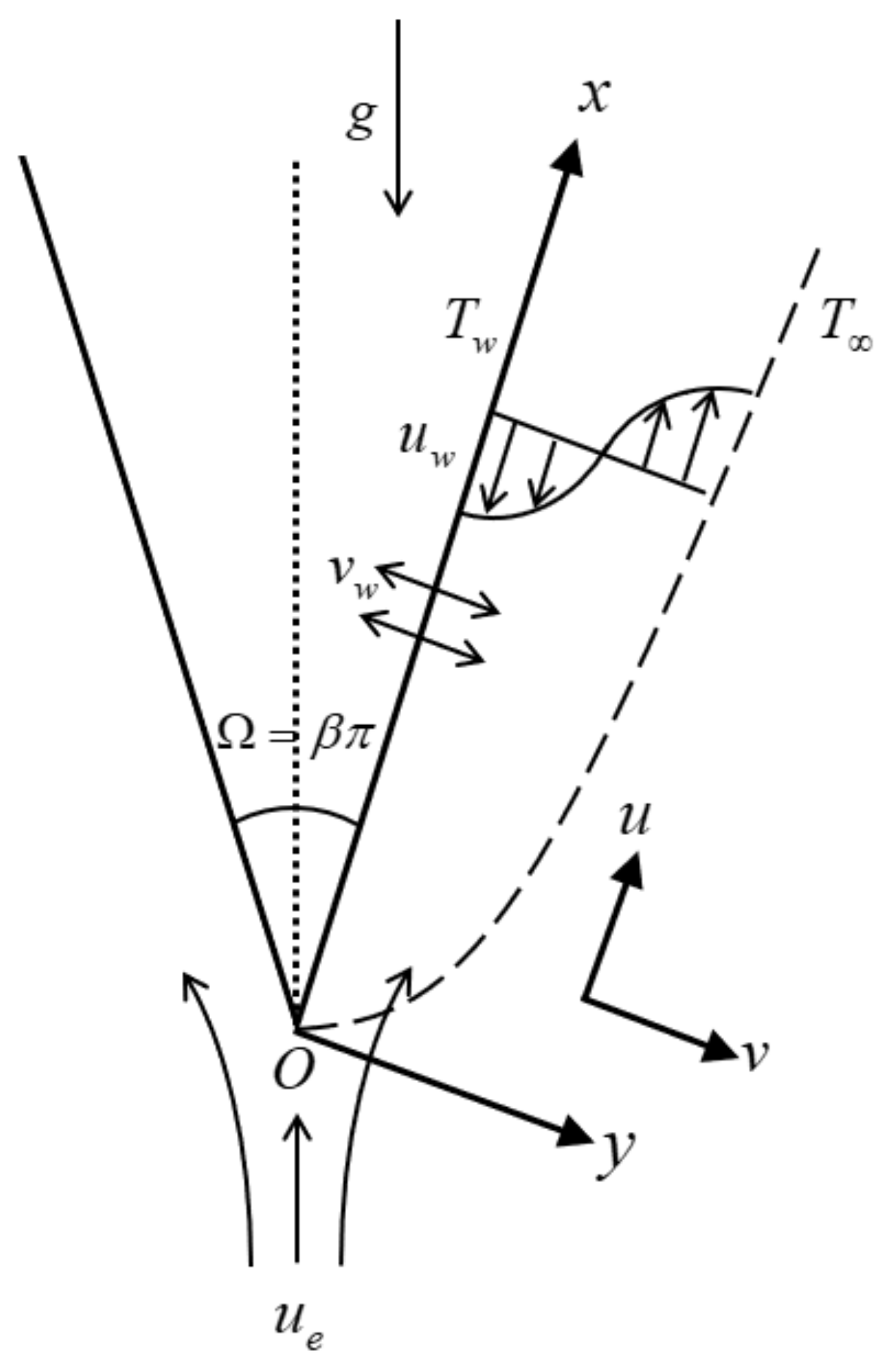
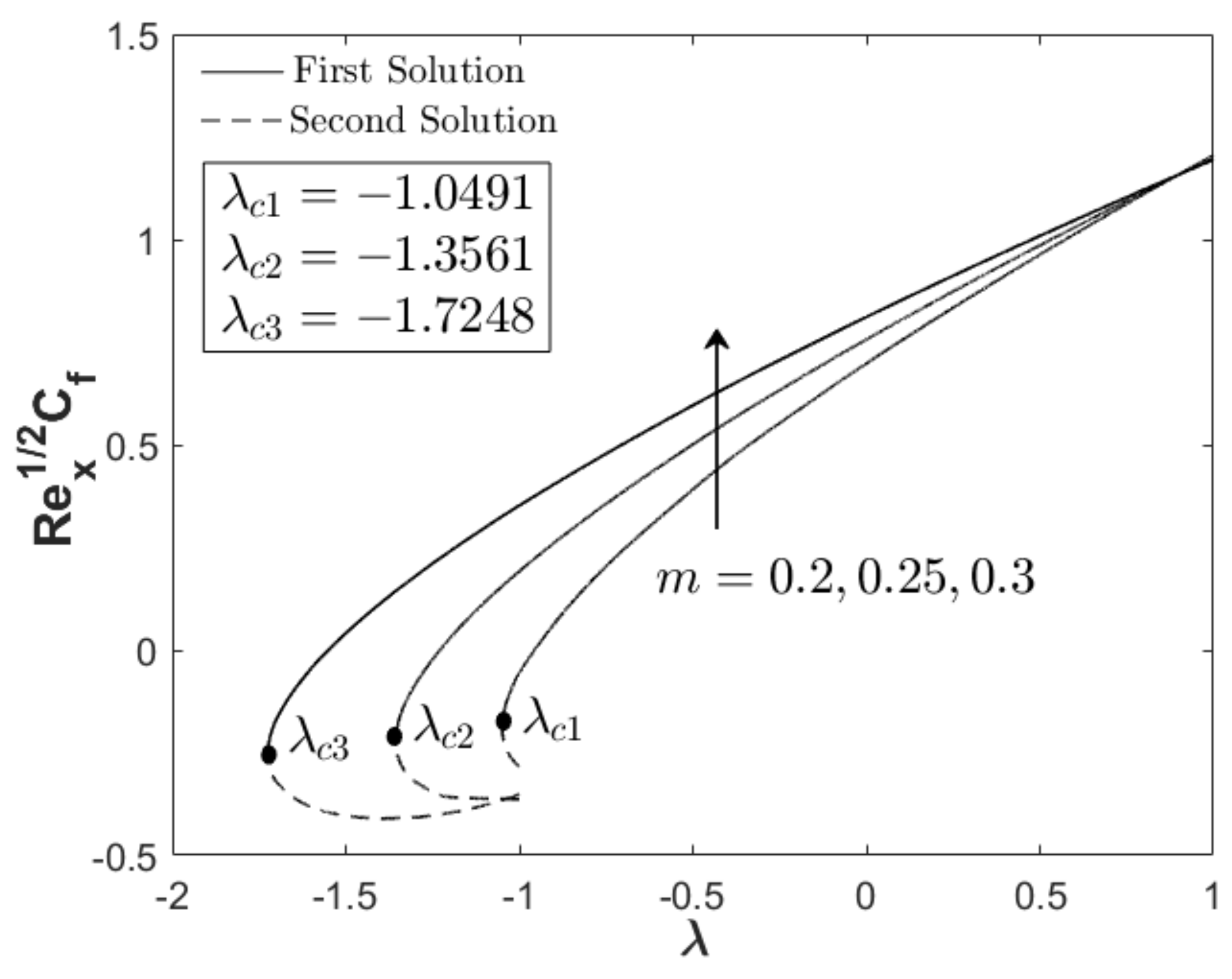
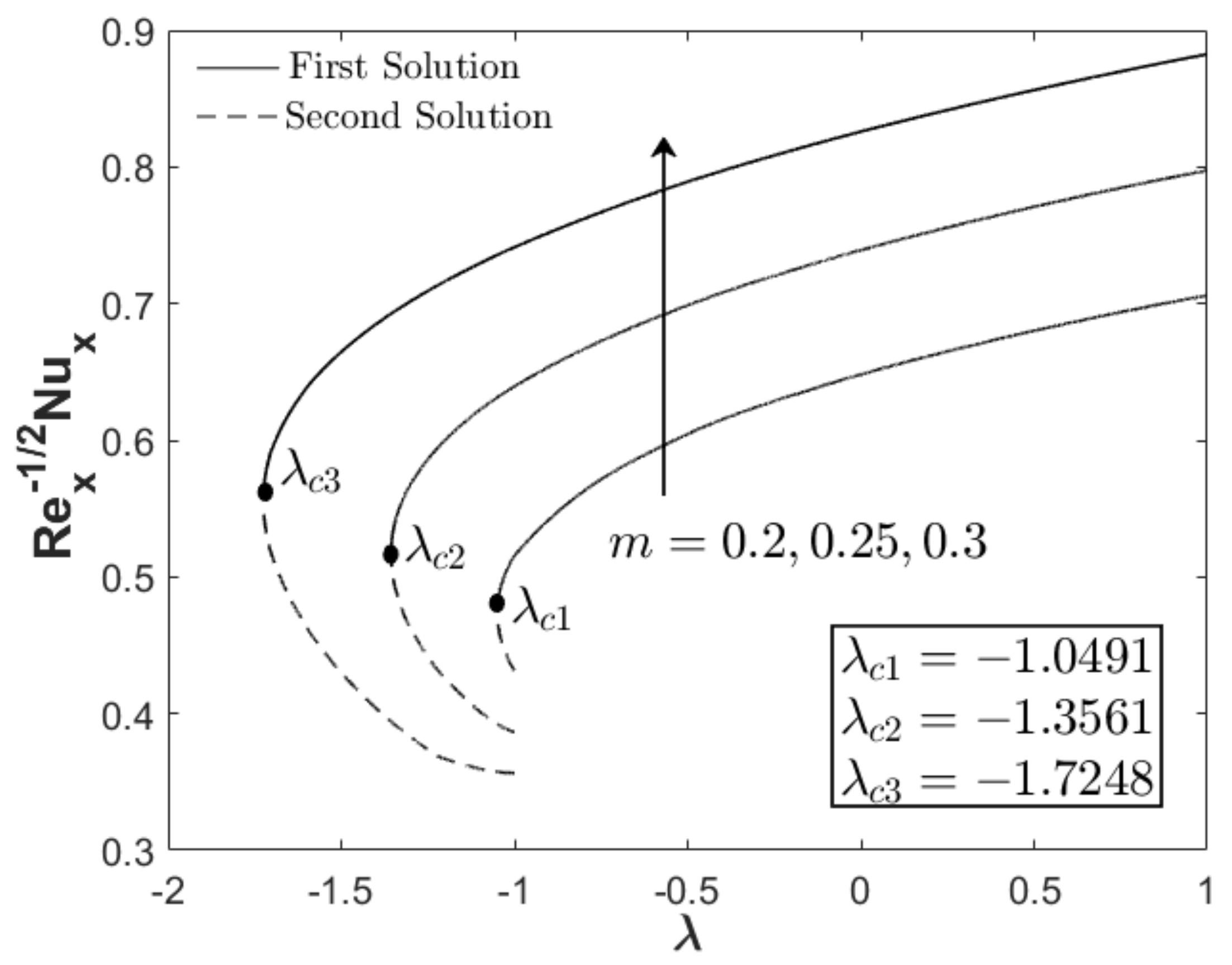
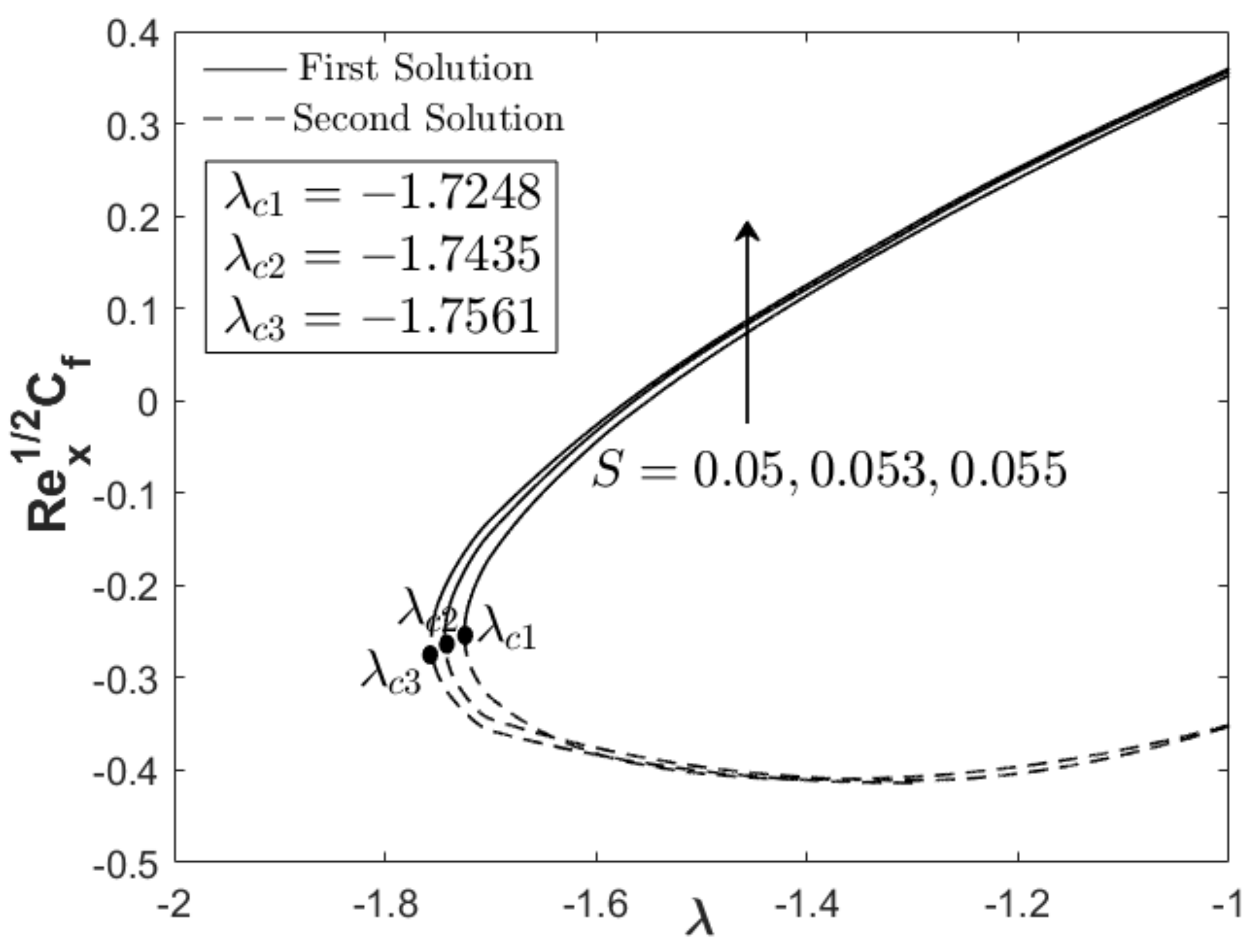
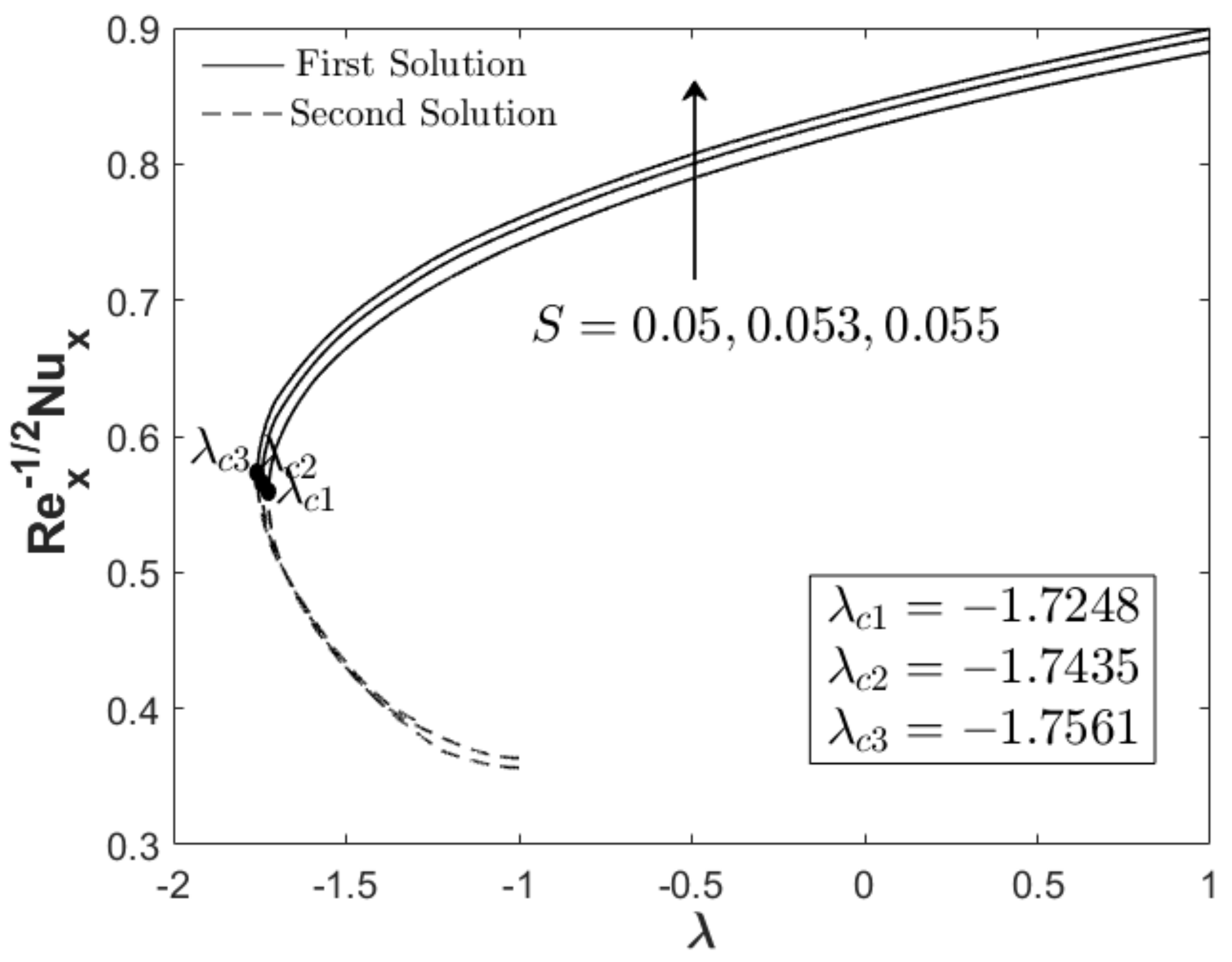
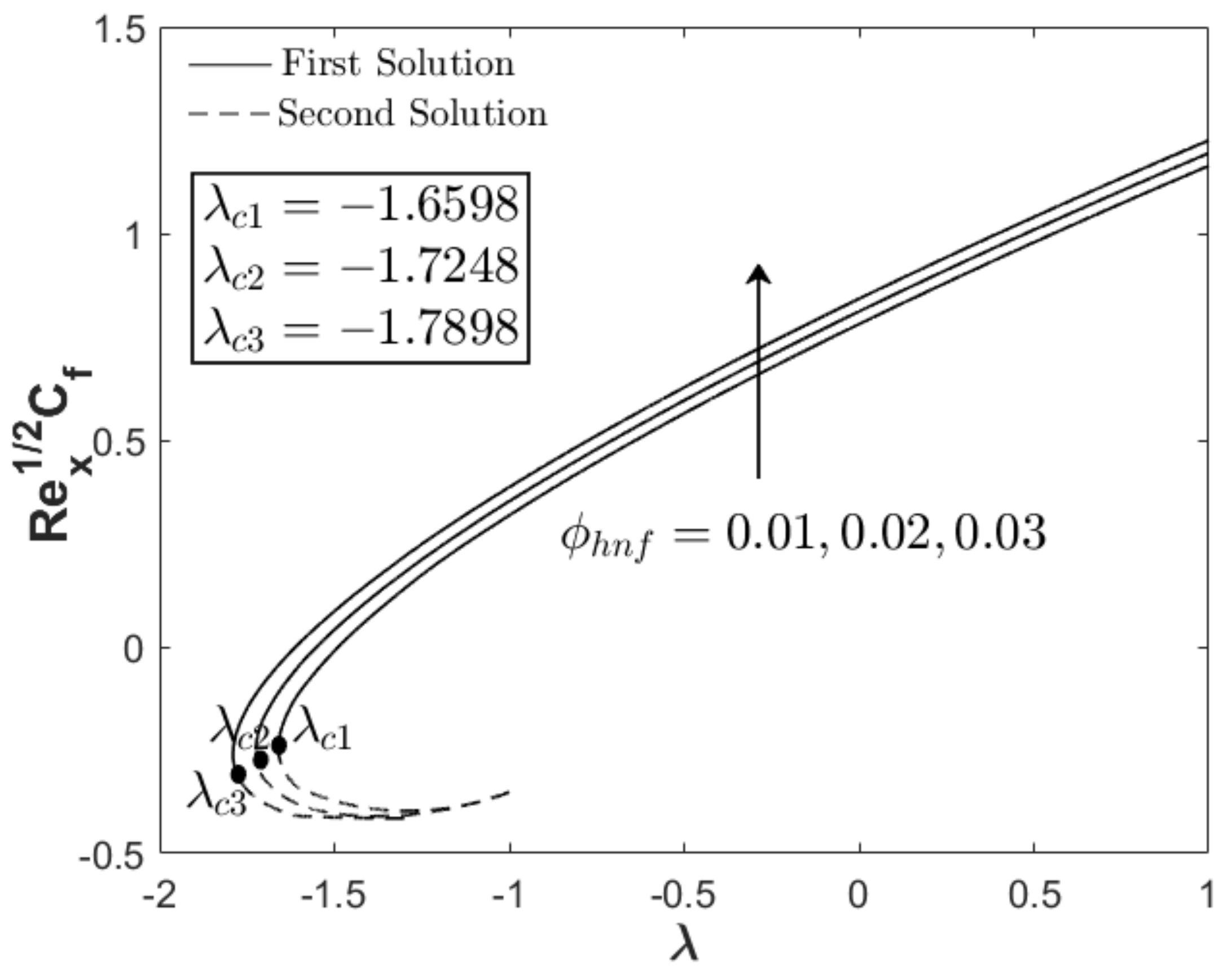
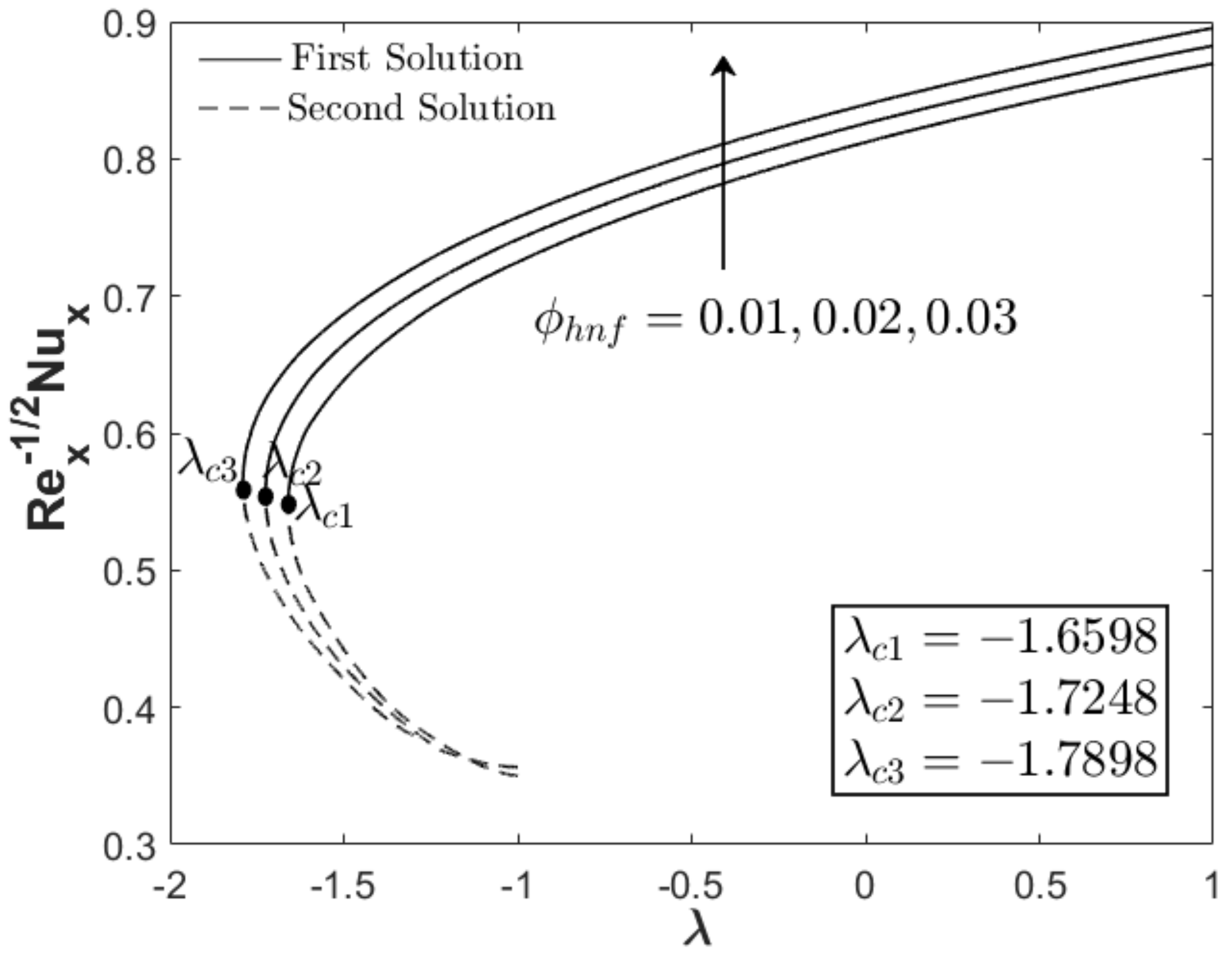
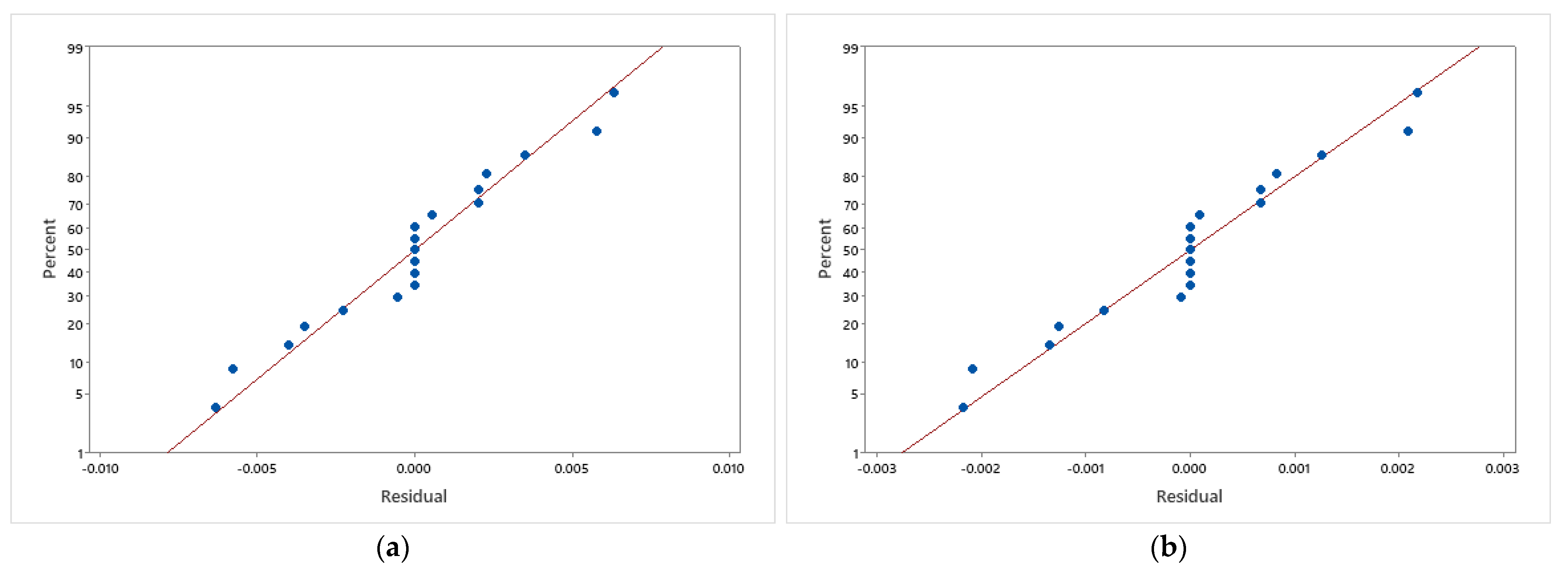
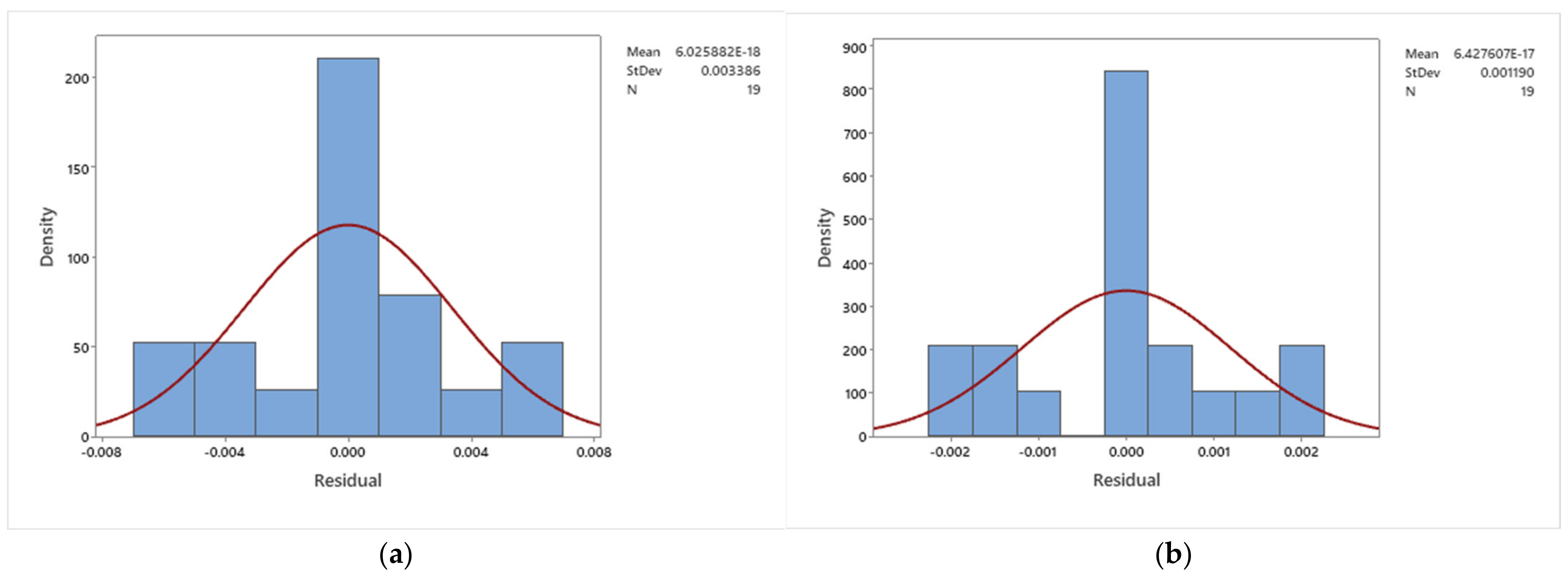
| Properties | Correlations |
|---|---|
| Thermal conductivity | |
| Thermal expansion | |
| Heat capacity | |
| Density | |
| Dynamic viscosity |
| Properties | Water | Copper | Alumina |
|---|---|---|---|
| 997.1 | 8933 | 3970 | |
| 4179 | 385 | 765 | |
| 0.6130 | 400 | 40 | |
| Prandtl number, | 6.2 | - | - |
| Present | Waini et al. [28] | Waini et al. [48] | |
|---|---|---|---|
| 0 | 1.2968902 | 1.296890 | 1.296890 |
| 0.25 | 1.5538496 | 1.553850 | 1.553850 |
| 0.2 | 0.05 | 0.02 | −1.0491 |
| 0.25 | −1.3561 | ||
| 0.3 | −1.7248 | ||
| 0.053 | −1.7435 | ||
| 0.055 | −1.7561 | ||
| 0.05 | 0.01 | −1.6598 | |
| 0.03 | −1.7898 |
| Factor | Symbol | Level | ||
|---|---|---|---|---|
| Low (−1) | Medium (0) | High (1) | ||
| A | 0.2 | 0.25 | 0.3 | |
| B | 0.05 | 0.053 | 0.055 | |
| C | 0.01 | 0.02 | 0.03 | |
| Runs | Real Values | Coded Values | Responses | |||||
|---|---|---|---|---|---|---|---|---|
| A | B | C | Skin Friction Coefficient | Heat Transfer Rate | ||||
| 1 | 0.2 | 0.053 | 0.03 | −1 | 0 | 1 | 0.008650682 | 0.549364184 |
| 2 | 0.2 | 0.053 | 0.01 | −1 | 0 | −1 | −0.100846497 | 0.506083442 |
| 3 | 0.25 | 0.053 | 0.02 | 0 | 0 | 0 | 0.198181909 | 0.651293721 |
| 4 | 0.3 | 0.05 | 0.02 | 1 | −1 | 0 | 0.352159148 | 0.741277394 |
| 5 | 0.25 | 0.053 | 0.02 | 0 | 0 | 0 | 0.198181909 | 0.651293721 |
| 6 | 0.3 | 0.053 | 0.03 | 1 | 0 | 1 | 0.390631245 | 0.768679201 |
| 7 | 0.25 | 0.053 | 0.02 | 0 | 0 | 0 | 0.198181909 | 0.651293721 |
| 8 | 0.25 | 0.05 | 0.01 | 0 | −1 | −1 | 0.156111888 | 0.623220285 |
| 9 | 0.25 | 0.055 | 0.01 | 0 | 1 | −1 | 0.167034194 | 0.643437992 |
| 10 | 0.3 | 0.053 | 0.01 | 1 | 0 | −1 | 0.322494736 | 0.736190043 |
| 11 | 0.25 | 0.053 | 0.02 | 0 | 0 | 0 | 0.198181909 | 0.651293721 |
| 12 | 0.25 | 0.05 | 0.03 | 0 | −1 | 1 | 0.226804209 | 0.65487521 |
| 13 | 0.25 | 0.053 | 0.02 | 0 | 0 | 0 | 0.198181909 | 0.651293721 |
| 14 | 0.25 | 0.055 | 0.03 | 0 | 1 | 1 | 0.236762452 | 0.674480548 |
| 15 | 0.3 | 0.055 | 0.02 | 1 | 1 | 0 | 0.35968123 | 0.760184189 |
| 16 | 0.2 | 0.05 | 0.02 | −1 | −1 | 0 | −0.054533056 | 0.515546913 |
| 17 | 0.25 | 0.053 | 0.02 | 0 | 0 | 0 | 0.198181909 | 0.651293721 |
| 18 | 0.2 | 0.055 | 0.02 | −1 | 1 | 0 | −0.029896804 | 0.540129695 |
| 19 | 0.2 | 0.053 | 0.03 | −1 | 0 | 1 | 0.008650682 | 0.549364184 |
| Source | DF | Seq SS | Contribution | Adj SS | Adj MS | F-Value | p-Value |
|---|---|---|---|---|---|---|---|
| A | 1 | 0.347418 | 94.01% | 0.344435 | 0.344435 | 15024.57 | 0.000 |
| B | 1 | 0.000352 | 0.10% | 0.000352 | 0.000352 | 15.34 | 0.004 |
| C | 1 | 0.013317 | 3.60% | 0.013790 | 0.013790 | 601.55 | 0.000 |
| A*B | 1 | 0.000073 | 0.02% | 0.000073 | 0.000073 | 3.19 | 0.108 |
| A*C | 1 | 0.000238 | 0.06% | 0.000549 | 0.000549 | 23.93 | 0.001 |
| B*C | 1 | 0.000000 | 0.00% | 0.000000 | 0.000000 | 0.01 | 0.922 |
| A*A | 1 | 0.007931 | 2.15% | 0.007683 | 0.007683 | 335.16 | 0.000 |
| B*B | 1 | 0.000000 | 0.00% | 0.000000 | 0.000000 | 0.01 | 0.933 |
| C*C | 1 | 0.000008 | 0.00% | 0.000008 | 0.000008 | 0.34 | 0.574 |
| Error | 9 | 0.000206 | 0.06% | 0.000206 | 0.000023 | ||
| Lack-of-Fit | 3 | 0.000206 | 0.06% | 0.000206 | 0.000069 | * | * |
| Pure Error | 6 | 0.000000 | 0.00% | 0.000000 | 0.000000 | ||
| Total | 18 | 0.369543 | 100.00% | ||||
| A | 1 | 0.108745 | 96.40% | 0.107718 | 0.107718 | 38033.61 | 0.000 |
| B | 1 | 0.000868 | 0.77% | 0.000868 | 0.000868 | 306.35 | 0.000 |
| C | 1 | 0.002602 | 2.31% | 0.002606 | 0.002606 | 920.21 | 0.000 |
| A*B | 1 | 0.000008 | 0.01% | 0.000008 | 0.000008 | 2.84 | 0.126 |
| A*C | 1 | 0.000019 | 0.02% | 0.000038 | 0.000038 | 13.54 | 0.005 |
| B*C | 1 | 0.000000 | 0.00% | 0.000000 | 0.000000 | 0.03 | 0.860 |
| A*A | 1 | 0.000519 | 0.46% | 0.000489 | 0.000489 | 172.82 | 0.000 |
| B*B | 1 | 0.000013 | 0.01% | 0.000012 | 0.000012 | 4.24 | 0.070 |
| C*C | 1 | 0.000002 | 0.00% | 0.000002 | 0.000002 | 0.71 | 0.423 |
| Error | 9 | 0.000025 | 0.02% | 0.000025 | 0.000003 | ||
| Lack-of-Fit | 3 | 0.000025 | 0.02% | 0.000025 | 0.000008 | * | * |
| Pure Error | 6 | 0.000000 | 0.00% | 0.000000 | 0.000000 | ||
| Total | 18 | 0.112801 | 100.00% | 0.112801 | |||
| S | R-sq | R-sq (adj) | R-sq (pred) |
|---|---|---|---|
| 0.0047880 | 99.94% | 99.89% | 99.19% |
| 0.0016829 | 99.98% | 99.95% | 99.67% |
| Term | Coef | SE Coef | 95% CI | T-Value | p-Value | VIF |
|---|---|---|---|---|---|---|
| Constant | 0.19818 | 0.00195 | (0.19376, 0.20260) | 101.39 | 0.000 | |
| A | 0.19995 | 0.00163 | (0.19626, 0.20364) | 122.57 | 0.000 | 1.04 |
| B | 0.00663 | 0.00169 | (0.00280, 0.01046) | 3.92 | 0.004 | 1.00 |
| C | 0.04001 | 0.00163 | (0.03632, 0.04370) | 24.53 | 0.000 | 1.04 |
| A*B | −0.00428 | 0.00239 | (−0.00969, 0.00114) | −1.79 | 0.108 | 1.00 |
| A*C | −0.01084 | 0.00222 | (−0.01586, −0.00583) | −4.89 | 0.001 | 1.06 |
| B*C | −0.00024 | 0.00239 | (−0.00566, 0.00517) | −0.10 | 0.922 | 1.00 |
| A*A | −0.04114 | 0.00225 | (−0.04622, −0.03605) | −18.31 | 0.000 | 1.04 |
| B*B | −0.00019 | 0.00225 | (−0.00528, 0.00489) | −0.09 | 0.933 | 1.02 |
| C*C | −0.00131 | 0.00225 | (−0.00639, 0.00377) | −0.58 | 0.574 | 1.04 |
| Constant | 0.651294 | 0.000687 | (0.649740, 0.652848) | 947.97 | 0.000 | |
| A | 0.111817 | 0.000573 | (0.110520, 0.113114) | 195.02 | 0.000 | 1.04 |
| B | 0.010414 | 0.000595 | (0.009068, 0.011760) | 17.50 | 0.000 | 1.00 |
| C | 0.017393 | 0.000573 | (0.016096, 0.018690) | 30.33 | 0.000 | 1.04 |
| A*B | −0.001419 | 0.000841 | (−0.003322, 0.000485) | −1.69 | 0.126 | 1.00 |
| A*C | −0.002866 | 0.000779 | (−0.004629, −0.001104) | −3.68 | 0.005 | 1.06 |
| B*C | −0.000153 | 0.000841 | (−0.002057, 0.001750) | −0.18 | 0.860 | 1.00 |
| A*A | −0.010382 | 0.000790 | (−0.012169, −0.008596) | −13.15 | 0.000 | 1.04 |
| B*B | −0.001627 | 0.000790 | (−0.003413, 0.000160) | −2.06 | 0.070 | 1.02 |
| C*C | −0.000664 | 0.000790 | (−0.002450, 0.001123) | −0.84 | 0.423 | 1.04 |
Publisher’s Note: MDPI stays neutral with regard to jurisdictional claims in published maps and institutional affiliations. |
© 2022 by the authors. Licensee MDPI, Basel, Switzerland. This article is an open access article distributed under the terms and conditions of the Creative Commons Attribution (CC BY) license (https://creativecommons.org/licenses/by/4.0/).
Share and Cite
Khashi’ie, N.S.; Waini, I.; Mukhtar, M.F.; Zainal, N.A.; Hamzah, K.B.; Arifin, N.M.; Pop, I. Response Surface Methodology (RSM) on the Hybrid Nanofluid Flow Subject to a Vertical and Permeable Wedge. Nanomaterials 2022, 12, 4016. https://doi.org/10.3390/nano12224016
Khashi’ie NS, Waini I, Mukhtar MF, Zainal NA, Hamzah KB, Arifin NM, Pop I. Response Surface Methodology (RSM) on the Hybrid Nanofluid Flow Subject to a Vertical and Permeable Wedge. Nanomaterials. 2022; 12(22):4016. https://doi.org/10.3390/nano12224016
Chicago/Turabian StyleKhashi’ie, Najiyah Safwa, Iskandar Waini, Mohd Fariduddin Mukhtar, Nurul Amira Zainal, Khairum Bin Hamzah, Norihan Md Arifin, and Ioan Pop. 2022. "Response Surface Methodology (RSM) on the Hybrid Nanofluid Flow Subject to a Vertical and Permeable Wedge" Nanomaterials 12, no. 22: 4016. https://doi.org/10.3390/nano12224016
APA StyleKhashi’ie, N. S., Waini, I., Mukhtar, M. F., Zainal, N. A., Hamzah, K. B., Arifin, N. M., & Pop, I. (2022). Response Surface Methodology (RSM) on the Hybrid Nanofluid Flow Subject to a Vertical and Permeable Wedge. Nanomaterials, 12(22), 4016. https://doi.org/10.3390/nano12224016










